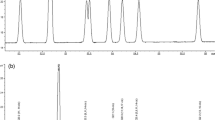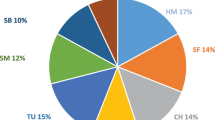Abstract
Fish is important in the traditional diet of Jamaicans, and the fishing industry contributes to social and economic development, as well as food security in Jamaica. However, there are associated health risks from contaminant exposure. The aim of this paper was to use risk-benefit analysis methods to determine the best fish species for consumption. Composite samples consisting of 14 fish species were collected from major fishing villages in 2016 and measured for total mercury, arsenic, selenium, and omega-3 fatty acids (EPA and DHA). Food frequency questionnaires were randomly distributed to 400 participants from different locations on the island. Participants were asked to identify the types of fish, portion size, and the frequency of consumption. An estimate of their weight was also recorded. Total mercury concentrations in fish samples ranged from 0.003 to 0.215 μg/g. The range of arsenic concentrations was 0.11 to 7.8 μg/g. The range of selenium concentrations was 0.302 μg/g to 1.08 μg/g. The mean omega-3 fatty acid concentration was 123.1 ± 93.6 mg/100 g. The fish consumption rates range from 3.2 to 1132.8 g/day. Cod fish was the most consumed species at 23.2 g/day. Four risk-benefit analysis methods were able to recommend four fish species that were best for consumption based on the levels of mercury, arsenic, selenium, and omega-3 fatty acids. They were doctorfish, parrotfish, snappers, and cod fish. The results of this study concluded that there was a low risk of mercury exposure from fish consumed in Jamaica.
Similar content being viewed by others
References
FAO (2016) Fishery and aquaculture country profiles. Jamaica. Country Profile Factsheet, Rome
FAO (2016) The State of the World Fisheries and Aquaculture 2016. Contributing to food security and nutrition for all, Rome
Kong A (2003) The Jamaica fishing industry: brief notes on it’s sturcture, socio-economic importance and some critical management issues. Judicial Symposia Papers.
Washington State Deparment of Health (2016) Health benefits of fish. http://www.doh.wa.gov/CommunityandEnvironment/Food/Fish/HealthBenefits.
Laird B, Chan HM, Kannan K, Husain A, Al-Amiri H, Dashti B, Sultan A, Al-Othman A, Al-Mutawa F (2017) Exposure and risk characterization for dietary methylmercury from seafood consumption in Kuwait. Sci Total Environ 607-608:375–380. https://doi.org/10.1016/j.scitotenv.2017.07.033
Cubadda F, Jackson BP, Cottingham KL, Van Horne YO, Kurzius-Spencer M (2017) Human exposure to dietary inorganic arsenic and other arsenic species: state of knowledge, gaps and uncertainties. Sci Total Environ 579:1228–1239. https://doi.org/10.1016/j.scitotenv.2016.11.108
Amlund H, Sele V, Sloth J (2018) Arsenic exposure from seafood consumption.145 -149. https://doi.org/10.1016/B978-0-12-409548-9.10929-7
US FDA (2014) A quantitaive assessment of the net effects on fetal neurodevelopment from eating commerical fish (As Measured by IQ and also by Early Age Verbal Development in Children).
Ralston NV, Raymond L (2018) Mercury’s neurotoxicity is characterized by its disruption of selenium biochemistry. Biochimica et Biophysica Acta (BBA) - General Subjects 1862(11):2405–2416. https://doi.org/10.1016/j.bbagen.2018.05.009
Depew D, Burgess N, Anderson MR, Baker R, Bhavsar SP, Bodaly RAD, Eckley CS, Evans MS, Gantner N, Graydon JA, Jacobs K, LeBlanc JE, St. Louis VL, Campbell LM (2013) An overview of mercury concentrations in freshwater fish species: a national fish mercury dataset for Canada. Can J Fish Aquat Sci 70:436–451
Neff MR, Robinson JM, Bhavsar SP (2013) Assessment of fish mercury levels in the upper St. Lawrence River. Canada. Journal of Great Lakes Research 39(2):336–343
Reyes ES, Aristizabal Henao JJ, Kornobis KM, Hanning RM, Majowicz SE, Liber K, Stark KD, Low G, Swanson HK, Laird BD (2017) Associations between omega-3 fatty acids, selenium content, and mercury levels in wild-harvested fish from the Dehcho Region, Northwest Territories, Canada. J Toxicol Environ Health A 80(1):18–31. https://doi.org/10.1080/15287394.2016.1230916
Karimi R, Fitzgerald TP, Fisher NS (2012) A quantitative synthesis of mercury in commercial seafood and implications for exposure in the United States. Environmental Health Perspectives 120(11):1512–1519. https://doi.org/10.1289/ehp.1205122
Cheng Z, Wang HS, Du J, Sthiannopkao S, Xing GH, Kim KW, Yasin MS, Hashim JH, Wong MH (2013) Dietary exposure and risk assessment of mercury via total diet study in Cambodia. Chemosphere 92(1):143–149. https://doi.org/10.1016/j.chemosphere.2013.02.025
Ricketts P, Basu N, Fletcher H, Voutchkov M, Bassaw B (2016) Assessment of fish consumption and mercury exposure among pregnant women in Jamaica and Trinidad & Tobago. Chemosphere 164:462–468
Burger J, Gochfeld M (2011) Mercury and selenium levels in 19 species of saltwater fish from New Jersey as a function of species, size, and season. Sci Total Environ 409(8):1418–1429. https://doi.org/10.1016/j.scitotenv.2010.12.034
Masters J (2015) Final CRFM Statistics information report:2014
Goodrich JM, Chou HN, Gruninger SE, Franzblau A, Basu N (2016) Exposures of dental professionals to elemental mercury and methylmercury. J Expo Sci Environ Epidemiol 26(1):78–85. https://doi.org/10.1038/jes.2015.52
Folch J, Lees M, Sloane Stanley GH (1957) A simple method for the isolation and purification of total lipides from animal tissues. Journal of Biological Chemistry 226:497–509
Strandberg U, Palviainen M, Eronen A, Piirainen S, Lauren A, Akkanen J, Kankaala P (2016) Spatial variability of mercury and polyunsaturated fatty acids in the European perch (Perca fluviatilis) - Implications for risk-benefit analyses of fish consumption. Environ Pollut 219:305–314. https://doi.org/10.1016/j.envpol.2016.10.050
Ralston NV, Ralston C, Raymond L (2016) Selenium health benefit values: updated criteria for mercury risk assessments. Biological Trace Element Research 171:262 -269. https://doi.org/10.1007/s12011-015-0516-z
Gewurtz SB, Bhavsar SP, Fletcher R (2011) Influence of fish size and sex on mercury/PCB concentration: importance for fish consumption advisories. Environ Int 37(2):425–434. https://doi.org/10.1016/j.envint.2010.11.005
Burger J, Gochfeld M (2013) Selenium and mercury molar ratios in commercial fish from New Jersey and Illinois: variation within species and relevance to risk communication. Food and chemical toxicology : an international journal published for the British Industrial Biological Research Association 57:235–245
Dewailly E, Rouja P, Dallaire R, Pereg D, Tucker T, Ward J, Weber JP, Maguire JS, Julien P (2008) Balancing the risks and the benefits of local fish consumption in Bermuda. Food Addit Contam Part A Chem Anal Control Expo Risk Assess 25(11):1328–1338. https://doi.org/10.1080/02652030802175285
Olmedo P, Pla A, Hernandez AF, Barbier F, Ayouni L, Gil F (2013) Determination of toxic elements (mercury, cadmium, lead, tin and arsenic) in fish and shellfish samples. Risk assessment for the consumers. Environ Int 59:63–72. https://doi.org/10.1016/j.envint.2013.05.005
Alamdar A, Eqani S, Hanif N, Ali SM, Fasola M, Bokhari H, Katsoyiannis IA, Shen H (2017) Human exposure to trace metals and arsenic via consumption of fish from river Chenab, Pakistan and associated health risks. Chemosphere 168:1004–1012. https://doi.org/10.1016/j.chemosphere.2016.10.110
Filippini T, Malavolti M, Cilloni S, Wise LA, Violi F, Malagoli C, Vescovi L, Vinceti M (2018) Intake of arsenic and mercury from fish and seafood in a Northern Italy community. Food Chem Toxicol 116 (Pt B):20-26. https://doi.org/10.1016/j.fct.2018.04.010
Delaware Sea Grant (2018) Seafood nutrition overview. https://www.seafoodhealthfacts.org/seafood-nutrition/healthcare-professionals/seafood-nutrition-overview.
Vilavert L, Borrell F, Nadal M, Jacobs S, Minnens F, Verbeke W, Marques A, Domingo JL (2017) Health risk/benefit information for consumers of fish and shellfish: FishChoice, a new online tool. Food Chem Toxicol 104:79–84. https://doi.org/10.1016/j.fct.2017.02.004
Hu XF, Laird BD, Chan HM (2017) Mercury diminishes the cardiovascular protective effect of omega-3 polyunsaturated fatty acids in the modern diet of Inuit in Canada. Environ Res 152:470–477. https://doi.org/10.1016/j.envres.2016.06.001
US EPA (2018) NATA Glossary of terms. https://www.epa.gov/national-air-toxics-assessment/nata-glossary-terms#hq.
Ralston NV, Kaneko J, Raymond L (2019) Selenium health benefit values provide a reliable index of seafood benefits vs. risks. Journal of Trace Elements in Medicine and Biology 55:50–57. https://doi.org/10.1016/j.jtemb.2019.05.009
Institute of Medicine (US) Panel on dietary antioxidants and related compounds (2000) Dietary Reference Intakes for Vitamin C, Vitamin E, Selenium, and Carotenoids Selenium
Caribbean Regional Fisheries Mechanism (2013) Fisheries exploited in Jamaican waters. http://www.crfm.net/index.php?option=com_k2&view=item&layout=item&id=52&Itemid=295. Accessed December 28 2018
Acknowledgments
We would like to thank Emmanuel Yumihoze for the assistance with total mercury, selenium, and total arsenic analysis. We also thank Linda Kimpe for the assistance with fatty acid analysis.
Funding
This study was funded by a Commonwealth Science Conference 2017 Follow-On Travel Grant from the Royal Society (CSC\R1\170037).
Author information
Authors and Affiliations
Corresponding author
Ethics declarations
All procedures performed in studies involving human participants were in accordance with the ethical standards of the University of the West Indies, Mona campus ethics committee and with the 1964 Helsinki declaration and its later amendments or comparable ethical standards.
Conflict of Interest
The authors declare that they have no conflict of interest.
Additional information
Publisher’s Note
Springer Nature remains neutral with regard to jurisdictional claims in published maps and institutional affiliations.
Rights and permissions
About this article
Cite this article
Ricketts, P., Voutchkov, M. & Chan, H.M. Risk-Benefit Assessment for Total Mercury, Arsenic, Selenium, and Omega-3 Fatty Acids Exposure from Fish Consumption in Jamaica. Biol Trace Elem Res 197, 262–270 (2020). https://doi.org/10.1007/s12011-019-01965-3
Received:
Accepted:
Published:
Issue Date:
DOI: https://doi.org/10.1007/s12011-019-01965-3




